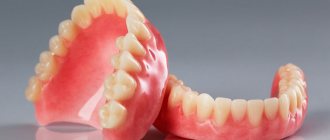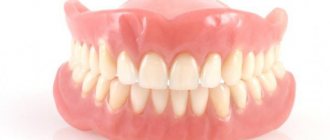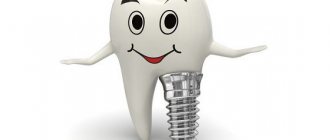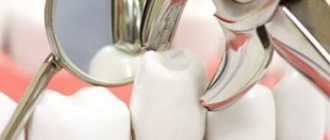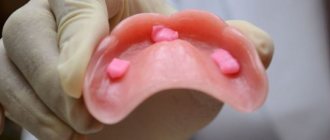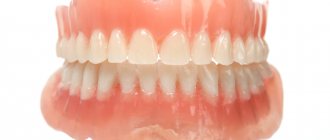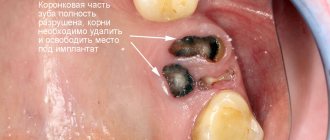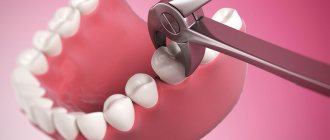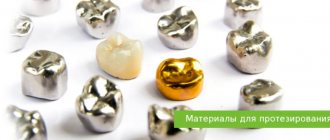Sooner or later, almost all people face the need to have dental prosthetics. Of course, it would be better if such a moment came as late as possible, but if problems with the dentition have arisen, they need to be resolved quickly so as not to cause irreparable harm to one’s own health. What dentures are best to put in if it’s time to “surrender” to the hands of an orthopedic dentist? To make a good choice, you need to know what dentures are in general and in what cases they are usually used.
What types of dentures are there for damaged teeth?
It often happens that the crown part of the tooth begins to collapse, but the root is completely healthy and sits firmly in the gum. In such cases, dentists do not recommend removal, because the root can be preserved and the crown part can be replaced with prosthetics - this is a more gentle and beneficial method for the patient to restore the defect. What dentures are available for such cases? There are several types of so-called microprostheses that will help restore the integrity of the dental crown:
- Tabs.
Simply put, these are large fillings made of ceramic or metal alloys that are made in a laboratory. The inlays exactly repeat the shape of the destroyed part of the crown and can serve as both an independent microprosthesis (restorative inlays) and a support for an artificial crown (stump). - Crowns.
The crown is the part of the tooth that we usually see and on which both the beauty of a smile and the quality of chewing food depend. Dentists install artificial crowns that cover the damaged tooth and completely cover the defects. They are made from metal-free ceramics (excellent aesthetics, good strength), metal ceramics (good strength and aesthetics) and plastic (suitable only for making temporary crowns, because such material is not very durable and stains over time). - Veneers.
For teeth in the “smile zone,” it is possible to install not entire crowns, but thin ceramic overlays on the front surfaces – veneers. They are installed if sufficient volume of the rear wall has been preserved and the microprosthesis can be securely fixed. Veneers are made from ceramics, and recently there are also designs made from zirconium dioxide. The simplest and most inexpensive option is composite veneers, formed from filling material directly on the patient’s teeth.
Orthopedic dentist at the 32 Dent clinic Veronika Aleksandrovna Ivantsova: “Microprostheses are good because they can restore both small defects (mainly veneers and lumineers) and seriously damaged teeth. We recommend our patients to fight for their own teeth to the last and, if possible, to preserve the dental unit - in no case to remove it.”
Which dentures are best to install: choose by cost
The most affordable microprostheses are inlays - they cost from 18,000 rubles. However, it is not always possible to get by with just one tab, so it is advisable for the patient to make a choice, guided not only by savings, but also by the advice of his doctor.
Veneers with lumineers will cost approximately the same - about 20-35 thousand rubles. Crowns differ slightly in price depending on the material: metal-free ceramics will cost about the same as a veneer, metal ceramics will cost 9-17 thousand rubles. Here you should choose according to the degree of destruction of dental tissues: if the defects are minor, you can get by with installing veneers. But in the case where the crown part of the tooth is seriously damaged, the installation of an artificial crown will be required.
If you have a problem similar to that described in this article, be sure to contact our specialists. Don't diagnose yourself!
Why you should call us now:
- We will answer all your questions in 3 minutes
- Free consultation
- The average work experience of doctors is 12 years
- Convenient location of clinics
Single contact phone number: +7
Make an appointment
Design Features
Butterfly prosthesis
is a small orthopedic structure for restoring 1-2 missing teeth. The prosthesis consists of the required number of artificial crowns, a small base and fastening elements - clasps. Clasps are small hooks made of plastic or metal that cover adjacent teeth or the alveolar process of the jaw and fix the structure in the oral cavity. It is thanks to its small size and the presence of hooks that the prosthesis was called a butterfly; the clasps resemble the wings of a butterfly. The product is also called an immediate denture, since it is used immediately after tooth extraction.
Butterfly is a very common method of replacing small defects in the dentition. The prosthesis is simple, inexpensive, accessible and comfortable. Therefore, it is used for temporary and permanent prosthetics. Of course, the product has its advantages and disadvantages, which the dentist tells the patient before treatment. The product is perfect for children and people with contraindications to implantation.
A butterfly prosthesis for a front tooth is the most inexpensive and easiest way to restore aesthetics and function. A well-chosen design is absolutely invisible to others. The disadvantage is the risk of the prosthesis shifting while eating, so you need to be careful and remember about the orthopedic structure in the oral cavity.
What types of dental prosthetics exist if only one tooth is missing?
If the destruction is so great that there is nothing left to save, you will still have to resort to removal. So, one tooth had to be removed, and now there is an unsightly empty space in its place. You should not wait for the “neighbors” in the dentition to move into the vacant space, disrupting the bite and interfering with normal chewing of food. It is better to immediately contact an orthopedic dentist, who will select the appropriate way to return the “prodigal” tooth to its place. There are several different ways to do this:
- Implantation.
A method that today is unrivaled in terms of reliability, durability and scope of function restoration. In modern dentistry it is considered simply ideal. If it is possible to carry out implantation, it is better to opt for this method of prosthetics. A titanium “artificial root” is screwed into the jawbone, onto which a crown made of metal-free ceramics or metal-ceramics is then installed. A very reliable and durable method that not only returns aesthetics to the dentition, but also almost completely restores its functions. - Bridge prosthesis.
A dental “bridge” is made of three interconnected crowns: one replaces a missing tooth, and the remaining two are attached to the supporting teeth and play the role of “bearing beams” of the bridge. The advantages of this method are affordable price and reliability, the disadvantages are the need to grind the supporting teeth, as well as the need to remove the entire prosthesis if it breaks. - Adhesive prosthetics .
The method is similar to installing a conventional bridge with support on the teeth adjacent to the defect. But at the same time, turning these “supports” is not required: the doctor will simply make micro-incisions on the tooth enamel, into which he will place a strong fiberglass thread and secure it with the help of composites. A more gentle and faster method of prosthetics than installing a “classical” bridge, but not as durable and reliable (recommended only for front teeth that do not bear the same load as chewing teeth). - CBW prosthetic system with micro-locks
. Here, too, neighboring teeth are used as a support for the prosthetic crown, but they do not have to be ground down. It will be enough to make small holes to fix the micro-locks that will hold the crown. A fairly reliable and quick way to restore a defect, however, dentists consider it not very durable and often recommend using it as a temporary option. - Immediate prosthesis, or “butterfly”.
What could be easier than installing a neat, removable structure with nylon or metal wire fastenings? Such a prosthesis does not scratch the enamel, is quickly installed and removed just as quickly, and does not require grinding of dental tissues. It would seem like a patient’s dream. But in fact, an immediate denture is quite uncomfortable when worn constantly, it is short-lived and is not intended to permanently replace a lost tooth. This is a temporary structure, which is usually installed for the period while a permanent prosthesis is being made.
Comparing prices: which method is more affordable?
The cheapest option is an immediate prosthesis, its cost will be about 2000-5000 rubles. But, as already mentioned, this is a temporary solution: you can wear it for no more than 2-3 months, and then you will need to change it to a permanent structure. An adhesive prosthesis will cost about 6,000-10,000 rubles, which is a very reasonable price for good aesthetics and reliable fixation. However, in terms of durability, adhesive structures are inferior to the same bridges (their price is the sum of the cost of individual crowns; if one crown costs 20-40 thousand rubles, then for a bridge this amount should be multiplied by three). Implantation will cost 20-70 thousand rubles, depending on the type of implant chosen. That is, implantation costs about the same as a good bridge structure, but at the same time it is much more reliable, more durable and does not require grinding of supporting dental units.
How many implants are needed?
Possible options:
- 2 classic (two-piece) implants are implanted along the edges of the defect, after healing they are loaded with a permanent prosthesis of 3 connected crowns (2 “sit” on the implants at the edges, 1 in the middle fills the void);
- 3 classic (two-piece) implants replace missing teeth with individual implants and load them with separate crowns after implantation of artificial roots;
- 3-4 monoblock (one-stage) implants on titanium roots immediately fix an adaptive prosthesis with a titanium arch and three welded crowns.
The choice of the number of implants depends on the location of the defect.
Which teeth are best to insert in case of multiple defects?
If you had to part with several teeth at once, you can restore each of them separately with implantation. To do this, you will have to be patient, because implants need about six months for final engraftment. But the result is worth it: at least for the next 20-30 years, you can forget about prosthetics. If financial capabilities and the condition of the body allow, you can opt for implantation. But there are other options, simpler and less expensive:
- Bridges.
They can restore up to 3-4 missing teeth in a row. - Clasp dentures.
This is one of the varieties of removable structures, which consists of a plastic gum base with crowns attached to it and a metal arch, which is the frame. The clasp is attached to the supporting teeth using hooks (clasps), clasps (attachments) or telescopic crowns. If necessary, it can be easily removed and just as easily installed back. - Removable dentures
. The simplest designs to install, which, however, are inferior in functionality and wearing comfort to both bridge and clasp prostheses. What types of removable dentures are there? They can be nylon - softer and more elastic, or acrylic - tougher, better able to withstand chewing loads. The first ones are more comfortable, the second ones are more functional.
Which dentures are the best in price?
When a patient chooses which dentures are best, they often look for price. You already know the cost of bridge structures, removable ones will cost about 15 thousand rubles, clasp ones - 30-60 thousand rubles with fastenings on clasps or attachments and 60-120 thousand rubles with fastening on telescopic crowns.
What to choose, removable or partially removable dentures – which is better? If you focus only on cost, then the first ones certainly win. But in terms of durability, wearing comfort and functionality, the latter are the leaders.
Bone grafting for jaw implantation
The more implants are installed, the greater the likelihood that the existing bone tissue will not be enough to install implants and it will be necessary to build it up. Bone deficiency can be in thickness (very thin bone) or in height (close to the maxillary sinuses in the upper jaw, nerve in the lower jaw).
If there is a slight lack of bone tissue in thickness, one-step bone grafting with the installation of implants is possible. It is also possible to carry out a sinus lift (a type of bone tissue augmentation when the distance to the maxillary sinus is insufficient) with the one-step installation of implants.
If there is a large deficiency of bone tissue, operations are first performed to build it up (open sinus lift, harvesting and replanting of a bone block), and after 3-6 months, implantation is performed. In this case, the total duration of treatment can be from one to one and a half years.
What teeth to put in if the jaw is completely “empty”?
Unfortunately, it also happens that a person is left completely without teeth on one of the jaws, and sometimes on both at once. What should he do in this case? Of course, you can just come to the dental clinic and ask: “I want to insert teeth - which ones are better? Tell". But it is advisable to understand at least a little about the issue of prosthetics in order to make the best choice. What does dentistry offer for complete edentia? Here are the main ways to restore teeth in this case:
- Complete removable dentures.
Very easy to install structures, which are artificial gums (base) made of acrylic or nylon with crowns fixed on it.When a patient decides to install complete removable dentures, which is better to choose - acrylic or nylon? There is no clear answer here; you need to look at the specific clinical situation and the wishes of the patient himself. In some cases, nylon is preferable, since it looks much better, is more comfortable to wear and can be installed by people in extreme professions (acrylic will not suit them, because due to its rigidity it can cause injury in the process of a fall or other unforeseen event). But sometimes it’s better to go with acrylic, which is stronger and better withstands chewing loads. When choosing removable dentures for teeth (which is better), you should ask your dentist - he will give individual recommendations.
- Prosthetics on implants.
There are several options for such dental restoration: bridge structures on implants (in case of complete edentia, they are installed in “sections”: several dentures on one jaw), removable dentures on implants (this method is especially recommended for the lower jaw, on which the usual removable structure does not hold very securely) and even clasp ones. Implantation serves as a support for the main prosthesis and makes it more reliable. If the patient is not afraid of serious stress on the body and is ready to invest a lot of money in restoring the health of his oral cavity, he can carry out a complete implantation of the entire dentition; modern technologies allow this possibility. - All-on-4.
A modern and very reliable method of restoring teeth, which is much more economical than full implantation. The essence of the method is that four implants are implanted into the jaw, on which the main structure is then installed, restoring the entire dentition.
Dental surgeon, implantologist at the 32 Dent clinic Sergey Leonidovich Yakubovsky: “We recommend All-on-4 prosthetics to patients with complete edentia as a gentle and very reliable way to regain their teeth. Full implantation is quite a serious burden on both the body and the patient’s wallet. And here there is an opportunity to restore the dentition at an affordable price, for a long time and with good aesthetics.”
Which teeth are better to insert: prices for prosthetics
Complete removable structures will cost 15-55 thousand rubles. If you plan to install them on implants, the cost of implantation will be added here, so the price will be higher - from 58 to 80 thousand rubles. All-on-4 prosthetics will cost approximately 50-60 thousand rubles (depending on the chosen main prosthetic design and types of implants).
Which dentures are best to install?
? It is advisable to at least have a rough idea of what you want when going to the dentist. And the doctor will help you navigate and choose the optimal method for a particular case, tell you about all the pros and cons of the chosen method and carry out proper installation. The main thing is to choose a good doctor!
Prices
| Service | Price |
| Prosthetics with partial removable plate dentures | from 17,000 rub. |
| Prosthetics with partial removable lamellar dentures (immediate denture) | from 7,500 rub. |
| Prosthetics with removable clasp dentures | from 40,000 rub. |
| Dental prosthetics with complete removable plate dentures (immediate denture) | from 8,000 rub. |
| Restoring the integrity of the dentition with fixed bridges (tooth) | from 14,700 rub. |
| Restoring the integrity of the dentition with fixed bridges (crown) | from 18,400 rub. |
To avoid possible misunderstandings, please clarify the cost of services in clinics with the administrator or during a consultation with a doctor. Prices on the website are not a public offer.
Sign up for a consultation
Indications and contraindications for production
A butterfly denture is made in the following clinical situations:
- Loss of 1-3 teeth in the front or side of the jaw;
- The need for prosthetics for 2-3 teeth;
- Partial edentia;
- Absence of a tooth by nature;
- Temporary replacement of a defect during the manufacture of a permanent structure;
- Inability to perform prosthetics using other prostheses;
- Presence of contraindications to implantation;
- Patient's wishes.
Contraindications to prosthetics are:
- Absence of more than 3 teeth in a row;
- Severe tissue atrophy;
- Periodontal diseases of adjacent teeth;
- Stomatitis, acute inflammatory processes in the oral cavity;
- Allergy to manufacturing materials (plastic, nylon);
- Deformation or defect of the alveolar process;
- Removal of the last molars, since their replacement is impractical.
Stages of treatment
Treatment begins with meeting the patient and consultation. The dentist examines the oral cavity, determines the presence of a defect, and offers the patient several methods of prosthetics. Additional research methods are carried out - radiography of teeth and jaws. The doctor talks about the advantages and disadvantages of the butterfly prosthesis and agrees on a prosthetic plan with the patient.
At the next visit, the oral cavity is prepared. Treatment of diseases of the teeth, gums and mucous membranes, as well as professional hygiene, is mandatory. If necessary, damaged teeth or roots are removed. Next, the specialist takes impressions of the jaws with a special impression material and transfers the impressions to the dental technician.
In the dental laboratory, jaw models are cast, the future prosthesis is modeled, the base is cast and the required number of artificial teeth is installed. The finished butterfly is carefully processed, sanded and polished until it shines. The product is sent to the dental clinic.
During a visit to the dentist, a fitting is carried out, the doctor evaluates the fit of the clasps, fixation of the product, bite and occlusion of the patient. If necessary, the prosthesis is corrected and additional polishing is carried out. The specialist tells you how to properly use the prosthesis and clean it, gives tips and recommendations.
After installing the prosthesis, a process of adaptation occurs - getting used to the product. It lasts differently for everyone and can take several hours or days depending on individual sensitivity. In any case, all the unpleasant sensations associated with the presence of a foreign body in the oral cavity will disappear after getting used to it. Immediately after fixing the butterfly, slight inflammation of the mucous membrane may occur at the border of the prosthesis transition or in the area of the clasps. If the pain is insignificant, then you can rinse with antiseptics or decoctions of medicinal herbs. If the pain is intense, increases or does not go away within several days, you should visit a doctor.
Advantages and disadvantages
The advantages of the product include the following factors:
- The ability to fully restore a defect in the dentition;
- Good fixation;
- Natural appearance;
- Invisibility to others;
- Sufficient strength;
- Fast manufacturing process;
- Low cost;
- Possibility of use in the presence of gum disease;
- Hypoallergenic and safe material of manufacture;
- Can be used as a temporary or permanent structure;
- Prevents bone tissue atrophy;
- Correctly distributes the chewing load throughout the jaw;
- Possibility to install a prosthesis immediately after removal;
- The design is easy to take off and put on;
- Simple hygienic care.
The disadvantages of the butterfly include the risk of chipping or breaking the product, since plastic or nylon are not very durable. The disadvantage is that it is fixed using clasps, which can weaken over time and if the pressure is too much, the prosthesis will simply fall off. Compared to other materials (ceramics, zirconium dioxide), plastic structures do not look aesthetically pleasing or natural enough.
We can conclude that the butterfly prosthesis is a good design and, given its cost, the advantages far outweigh the disadvantages.
Operation and care
Hygienic care with a butterfly prosthesis is not complicated and consists of the following:
- The structure must be cleaned every day, but it can be removed periodically at night;
- In the evening, the denture should be removed and cleaned with a toothbrush and toothpaste or soap;
- Place the cleaned product in a glass of water or a special cleaning solution;
- You should brush your teeth as usual 2 times a day: morning and evening;
- Particular attention should be paid to the places where the prosthesis is fixed, where the clasps are attached to natural teeth;
- You should eat solid foods carefully; the butterfly may break if overloaded;
- After each meal, it is recommended to rinse the mouth;
- Once every 6 months you should visit the dentist for a preventive examination of the oral cavity and the integrity of the orthopedic structure.
The cost of the structure will depend on the material used, the number of missing teeth and the dental clinic. A prosthesis made of acrylic plastic will cost much less than one made of nylon.


